You are given a phone number as a string number. number consists of digits, spaces ' ', and/or dashes '-'.
You would like to reformat the phone number in a certain manner. Firstly, remove all spaces and dashes. Then, group the digits from left to right into blocks of length 3 until there are 4 or fewer digits. The final digits are then grouped as follows:
- 2 digits: A single block of length 2.
- 3 digits: A single block of length 3.
- 4 digits: Two blocks of length 2 each.
The blocks are then joined by dashes. Notice that the reformatting process should never produce any blocks of length 1 and produce at most two blocks of length 2.
Return the phone number after formatting.
Example 1:
Input: number = "1-23-45 6" Output: "123-456" Explanation: The digits are "123456". Step 1: There are more than 4 digits, so group the next 3 digits. The 1st block is "123". Step 2: There are 3 digits remaining, so put them in a single block of length 3. The 2nd block is "456". Joining the blocks gives "123-456".
Example 2:
Input: number = "123 4-567" Output: "123-45-67" Explanation: The digits are "1234567". Step 1: There are more than 4 digits, so group the next 3 digits. The 1st block is "123". Step 2: There are 4 digits left, so split them into two blocks of length 2. The blocks are "45" and "67". Joining the blocks gives "123-45-67".
Example 3:
Input: number = "123 4-5678" Output: "123-456-78" Explanation: The digits are "12345678". Step 1: The 1st block is "123". Step 2: The 2nd block is "456". Step 3: There are 2 digits left, so put them in a single block of length 2. The 3rd block is "78". Joining the blocks gives "123-456-78".
Example 4:
Input: number = "12" Output: "12"
Example 5:
Input: number = "--17-5 229 35-39475 " Output: "175-229-353-94-75"
Constraints:
2 <= number.length <= 100numberconsists of digits and the characters'-'and' '.- There are at least two digits in
number.
Solution:
Time complexity: O(n)
Space complexity: O(1)
C++
|
1 2 3 4 5 6 7 8 9 10 11 12 13 14 15 16 17 18 19 20 |
// Author: Huahua class Solution { public: string reformatNumber(string number) { string ans; const int total = count_if(begin(number), end(number), [](char c) { return isdigit(c); }); int l = 0; for (char c : number) { if (!isdigit(c)) continue; ans += c; ++l; if ((l % 3 == 0 && total - l >= 4) || (total % 3 != 0 && total - l == 2) || (total % 3 == 0 && total - l == 3)) ans += "-"; } return ans; } }; |

